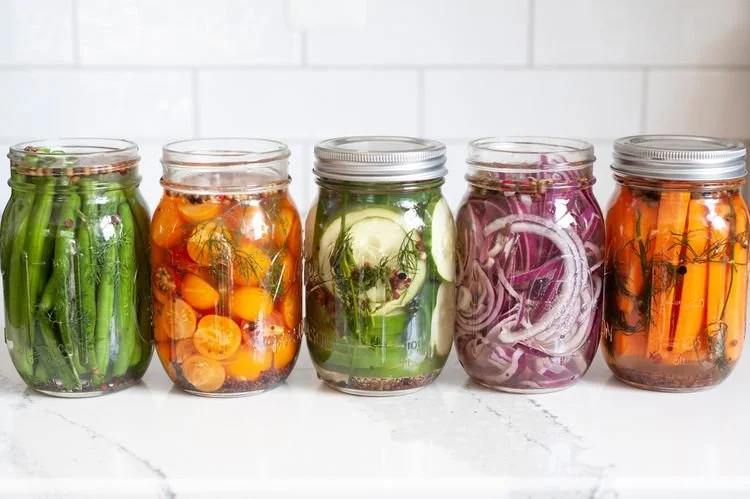How To Make Quick Pickles
2 Pints
Prep 20 min
Cook 5 min
Total 25min
Adapted from Simply Recipes
Turn excess vegetables into flavorful pickles that keep in the fridge for months.
Ingredients
1 pound fresh vegetables like cucumbers, carrots, peppers, zucchini, green beans or onions
1 cup water
1/2 cup white vinegar
1/2 cup apple cider vinegar
1 to 3 tablespoons sugar
2 to 3 teaspoons pickling, sea, or kosher salt
2 teaspoons dried whole spices, like black pepper, red pepper flakes, coriander, mustard seeds, and/or celery seed etc.
4 sprigs fresh dill, thyme or tarragon, etc. optional
Instructions
Prepare the vegetables:
Wash the vegetables. You can use all one variety or a mix of a few.
Slice carrots, cucumbers, radishes, and zucchini or squash into rounds or spears. Core and seed bell peppers, then slice into strips. Slice smaller peppers into rounds.
Snap the ends off of green beans. Peel and cut fennel and onions into thin slices; simply peel garlic. Trim cauliflower into small florets. Cut grape or cherry tomatoes in half or leave whole.
Pack the jars:
Pack the vegetables tightly into 2 clean pint jars leaving about 1 inch of headspace.
Make the brine:
Combine the water, vinegars, sugar, salt, spices, and dill (if using) in a medium saucepan.
Heat over medium heat, stirring occasionally, until the salt and sugar have dissolved. Let come to a boil and turn off the heat.
Pickle the vegetables:
Pour the hot brine over the vegetables, submerging all of the vegetables and leaving a 1/2-inch of headspace.
Wipe the rims and screw on new, clean lids.
Cool and store:
Let the jars cool on the counter until room temperature, about 1 hour.
Once cool, store in the fridge. The quick pickles can be enjoyed right away, although they’ll taste much better after 24 hours and even better after a week.
Quick pickles will keep for about 3 months in a sealed jar in the fridge.
What Vegetables are Best for Quick Pickling?
It’s almost easier to list veggies that aren’t good for quick pickling (potatoes come to mind). When assembling refrigerator pickles, you can pickle a singular vegetable or use a mix. The following are great options for quick pickling:
Cucumbers: The most pickled of all vegetables, cucumbers reliably make a great pickle. Small, crunchy varieties are especially good, but any kind will do. Consider peeling thick-skinned varieties and removing any big seeds.
Carrots: Cut into rounds or spears, carrots make a deliciously crunchy pickle. Peel and remove the tops before pickling.
Zucchini or squash: Zucchini and yellow squash pick up the flavors of brine easily. While they aren’t crunchy, they are a nice addition to sandwiches and antipasti.
Onions: Pickled onions are one of the most versatile pickles. Peel and slice large varieties thin and leave pearl onions whole before brining. Serve atop burgers, tacos, hot dogs, and more.
Peppers: From bell peppers to jalapeños, all peppers are good for pickling. Slice them into thin strips or rounds. Seed bell peppers, but leave the seeds in hot peppers for extra heat.
Green beans: Pickled green beans are a fun snack and make a unique addition to salads. To prepare, snap or cut off the tough ends. Leave them whole for an attractively long pickle.
Cauliflower: Raw cauliflower retains its crunch while absorbing the flavors of the brine, making it ideal for pickling. Mix it with carrot, onion, and jalapeños to make escabeche.
Other fun quick pickle ideas include radishes (trimmed and sliced or cut in half), fennel (cut into thin slices like onion), grape or cherry tomatoes (halved or left whole), and garlic (peeled).
The Brine
I like a ratio of 1 part vinegar to 1 part water, which imparts the perfect amount of tangy acidity. I also prefer a mix of white vinegar and apple cider vinegar for a clean but flavorful brine. You can use all white vinegar or all apple cider vinegar if you like.
You can flavor the brine in a number of ways. The only musts are salt and sugar, both of which can be adjusted to suit your tastes or the particular type of pickle you want to make.
For a sweet pickle, use up to 3 tablespoons of sugar and 2 teaspoons of salt.
For a milder pickle, use 4 teaspoons sugar and 2 teaspoons salt.
For a more savory pickle, use 2 teaspoons sugar and 3 teaspoons salt.
The Aromatics, Spices, and Herbs
Just as there are plenty of options when choosing what vegetables to pickle, there are even more options when it comes to flavoring them. I’ve listed some good options below and you can use any combination that sounds good to you.
Smashed garlic cloves
Fresh ginger slices
Fresh dill sprigs or heads of dill
Fresh thyme sprigs
Bay leaves
Black peppercorns (black, white, or a mix)
Mustard seeds (yellow or black)
Red pepper flakes (1/2 teaspoon or less)
Coriander seeds
Celery seeds
Fennel seeds
Whole cloves
Cinnamon sticks (one small stick or less per batch)
Dried oregano
Ground turmeric
Flavor combinations
Italian-inspired pickles: Zucchini and red bell peppers with 1 tablespoon sugar, 2 teaspoons salt, 6 smashed garlic cloves, 1 teaspoon oregano, 1/2 teaspoon fennel seeds, 1/2 to 1/4 teaspoon red pepper flakes
Sweet and spiced carrot pickles: Carrot coins with 3 tablespoons sugar, 2 teaspoons salt, 1-inch piece of fresh ginger cut into thin slices, 1 cinnamon stick, 6 cloves, 1/2 teaspoon ground turmeric
Spicy pickles: Cucumber rounds or spears and jalapeño rings with 2 tablespoons sugar, 3 teaspoons salt, 1 teaspoon black peppercorns, 1/2 teaspoon mustard seeds, 1/2 teaspoon red pepper flakes

